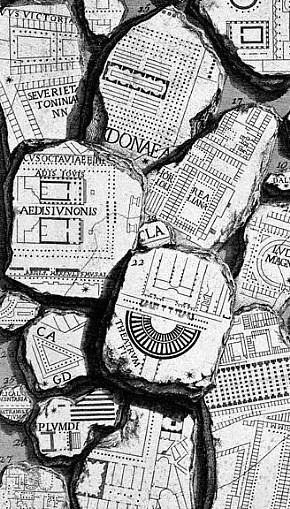1477
Bramante
Bramante's Milanese differs so much from his Roman work that it has been ascribed to a fictitious "Bramante of Milan."
1997.11.20
me and the Ichnographia
I also have some thoughts regarding the Ichnographia as a stone fragment: this presentation on Piranesi's part could also be considered a reenactment of the Forma Urbis--a virtual reenactment of discovering the great missing piece of the "puzzle" that will bring all the other piece to a grand cohesion. (I am here reminded of Tafuri's opening comments to The Sphere and the Labyrinth, and I'm sure I can now make a good valid connection and elaborate on how the fragment stone map of the Ichnographia represents a kind of "missing link," a piece that will explain all there is to explain about the "real" architecture of Imperial Rome.

"There comes a moment (though no always) in research when all the pieces begin to fall into place, as in a jig-saw puzzle, where all the pieces are near at hand and only one figure can be assembled (and thus the correctness of each move be determined immediately), in research only some of the piece are available, and theoretically more than one figure can be made from them, In fact, there is always the risk of using, more or less consciously, the pieces of he jig-saw puzzle as blocks in a construction game. For this reason, the fact that everything falls into place is an ambiguous sign: either one is completely right or completely wrong. When wrong, we mistake for objective verification the selection and solicitation (more or less deliberate) of the evidence, which is forced to confirm the presuppositions (more or less explicit) of the research itself. The dog thinks it is biting the bone and is instead biting its own tail."
Carlo Ginzburg and Adriano Prosperi, Giochi di pazienza: Un seminario sul "Beneficio di Cristo" (Turin: Einuadi, 1975), p. 84.
| |
1998.01.04
notation of existing Campo Marzio texts - Tafuri 2
Here are more Tafuri descriptions of the Ichnographia of the Campo Marzio as found in The Sphere and the Labyrinth:
a. a fully developed and articulated metaphor of the machine-universe.
b. polemical and self-critical.
c. a formless heap of fragments colliding one against another.
d. a formless tangle of spurious organism.
e. a homogeneous magnetic field jammed with objects having nothing to do with each other.
f. a kind of typological negation.
g. an "architectural banquet of nausea."
h. a semantic void created by an excess of visual noise.
i. a virtual catalogue
j. a typological sample book.
1998.01.07
more texts from Tafuri 2
"And thus the cause of the "decline and fall" is one alone--the loss of republican freedoms and the advent of a laxist aristocracy. The Piranesian "labyrinth" begins to give itself a political significance, cleverly disguised.
The ambiguity of the Campo Marzio now becomes evident; it is at once a "project" and a denunciation. As a disenchanted documentation of the impossibility of an unambiguous definition of language, it--projecting this situation into the past--sounds like a merciless satire of the infinite capacity of late-baroque typology to reproduce itself metamorphically. (The fact that in the Campo Marzio the allusion to baroque typologies is filtered through a classicist geometrism fools no one; it is simply a means of rendering metahistorical and universal the polemic already begun.) Inasmuch as it is--despite everything--an affirmation of a world of forms, the Campo Marzio, precisely because of the absurdity of its horror vacui, becomes a demand for language, a paradoxical revelation of its absence.
Negation and affirmation cannot split apart. The "na´ve dialectic" of the Enlightenment is already superseded.
The "great absentee" from the Campo Marzio, then, is language.
The absolute disintegration of formal order, of what remained of the huminist Stimmung, of its sacred and symbolic values--and, above all, of perspective as a symbolic instrument for the quantitative control of space--logically also affects the subject of Piranesi's work: the relationship between history and the present. On one side, there is painstaking , scientific study of archeological findings; on the other, the most absolute arbitrariness in their resolution. (In this respect, after all, the Campo Marzio is anything but an exception in Piranesi's work.) History no longer offers values as such. Subjected to a merciless inspection, it is revealed as a new principle of authority, which as such must be disputed. It is the experience of the subject that establishes values; in this, already lies all the aspiration to the negative polemic of romanticism. Is Piranesi the "archeologist" interested in caves, underground passages, and substructures purely by chance, then? Rather, cannot this interest in "what is hidden" in ancient architecture be interpreted as a metaphor for the search for a place in which the exploration of the "roots" of the monuments meets with the exploration of the depths of the subject?
Manfredo Tafuri, The Sphere and the Labyrinth - Avant-Gardes and Architecture from Piranesi to the 1970s (Cambridge: The MIT Press, 1987), p. 38.
| |
| |
|